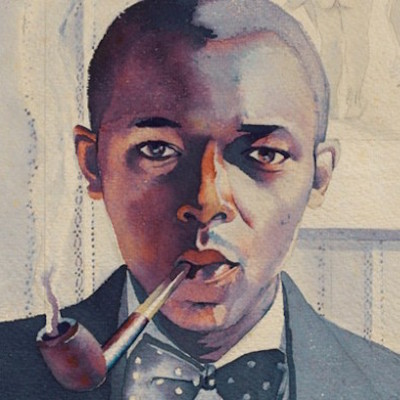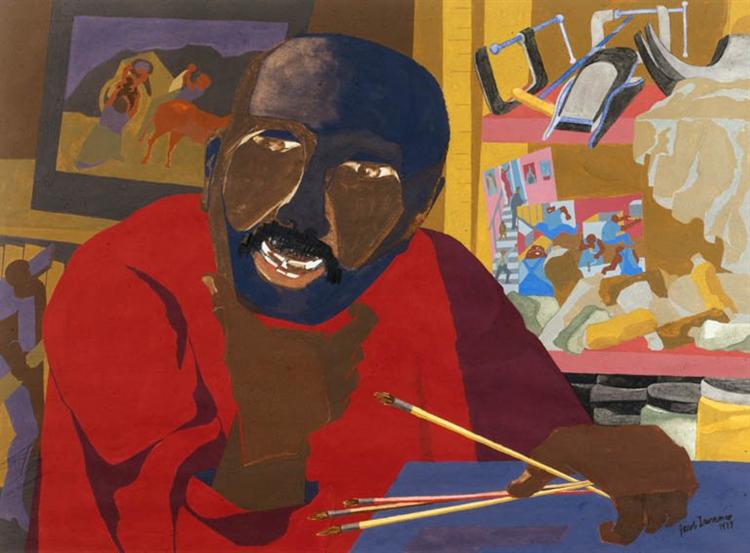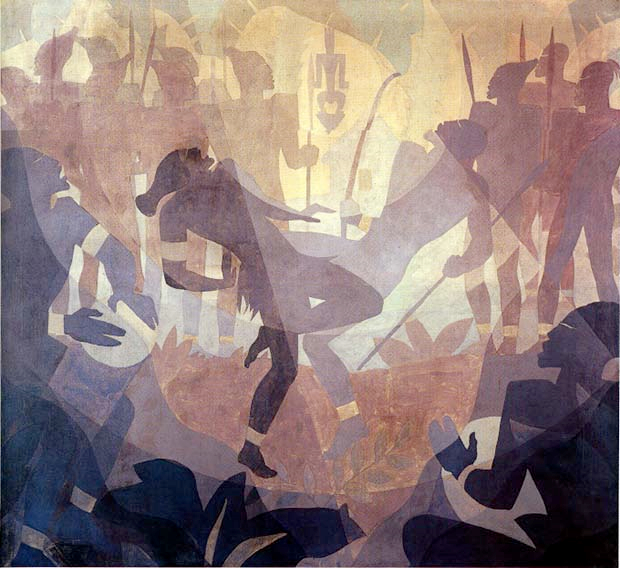African American Artist and the Public Works of Art Project
 Employment of Negroes in Agriculture by Earle Richardson, 1934
Employment of Negroes in Agriculture by Earle Richardson, 1934
Very little has been written about the African American artists who were employed by the Public Works of Art Project (PWAP). Nor is there a confirmed number of the artists. The agreed upon estimate is at least ten. According to author Gerald D. Jaynes, "Unfortunately, the short-lived PWAP only provided employment for a small number of black visual artists, a number of whom the government hired to paint murals on public buildings (p.57)." The first who was thought to be selected was Samuel Joseph Brown, Jr. of Philadelphia, PA. When the PWAP ended, Samuel J. Brown, Jr. stayed on with the national program's Philadelphia chapter. It is not know if Brown faced the same level of discrimination as that faced by artists in New York. According to author Dele Jegede, African American artists faced "blatant discrimination" from the PWAP and as a result formed their own organization, the Harlem Artists Guild, with Aaron Douglas serving as the first president. Aaron Douglas and Samuel J. Brown, Jr. are two of the few African American artists highlighted in this research guide. For more information consult the following sources.
SOURCES:
Jaynes, G. (2005). Encyclopedia of African American Society, volume 1. California, London, and New Delhi :Sage Publications, Inc.
Jegede, D. (2009). Encyclopedia of African American Artists: artists of the American mosaic. Westport, Connecticut and London: Greenwood Press.
Metropolitan Museum of Art, et. al. (2003). African American Artists, 1929-1945: prints, drawings, paintings in the Metropolitan Museum of Art. New Haven, Connecticut: Yale University Press.
Public Works of Art Bulletin. (1934).
Samuel Joseph Brown, Jr.

Smoking My Pipe by Samuel Joseph Brown, Jr., 1934
Samuel Joseph Brown, Jr. (1907 -1994) is thought to be the first African American artist hired for the Public Works of Art Project. He was born in North Carolina and his family later moved to Philadelphia, PA. He studied at the Pennsylvania Museum and the School of Industrial Art, and received a master of arts equivalent degree from the University of Pennsylvania.. Samuel J. Brown, Jr.'s watercolor painting of So Tired was exhibited at the Corcoran Gallery in Washington, D.C. in 1934. As a WPA artist, four of his watercolors were selected to be exhibited at the Philadelphia Museum of Art, though the museum was only to select one. In addition to his art, Samuel Joseph Brown, Jr. was a school teacher in the Philadelphia public school system for 30 years.
SOURCES:
Nicholson, J. (1994, October 26). Samuel J. Brown, Jr.; an artist and teacher. Philly.com. Retrieved from http://articles.philly.com/1994-10-26/news/25874928_1_wpa-watercolors-art-teacher
Richberg, B. (1994, October 27). Samuel Brown, 87, watercolorist whose work was widely acclaimed. Philly.com. Retrieved from http://articles.philly.com/1994-10-27/news/25871792_1_watercolor-harmon-foundation-fine-arts
Sims, L. S. (2003). Challenge of the modern: African-American artists 1925-1945, Volume 1. New York, NY: Studio Museum in Harlem.
Jacob Lawrence
 Self-portrait by Jacob Lawrence, 1977
Self-portrait by Jacob Lawrence, 1977
Jacob Lawrence (1917-2000) was born in Atlantic City, NJ. His parents were from South Carolina and Virginia, and after several moves, his parents split and Jacob's mother settled in Harlem in 1930. Jacob was enrolled in an arts and crafts program under the tutelage of Charles Alston. He also received support and guidance from Augusta Savage. It was with Savage's encouragement that Jacob Lawrence enrolled in the WPA as an artist. His career was launched with 41 pictorial narratives on Toussaint L'Ouverture, exhibited at the Baltimore Museum of Art in 1939. Jacob Lawrence earned three Julius Rosenwald Fund Fellowships.
SOURCES:
Jegede, D. (2009). Encyclopedia of African American Artists: artists of the American mosaic. Westport, Connecticut and London: Greenwood Press.
Marzec, R. P. (ed.) (2004). The Greenwood Encyclopedia of American Regional Cultures: the Mid-Atlantic Region. Westport, CT and London: Greenwood Press.
See additional artwork by Jacob Lawrence at WikiArt.org.
Aaron Douglas

Aspects of Negro Life: The Negro in an African Setting by Aaron Douglas, 1934
Aaron Douglas (1899-1979) participated in the 1934 traveling exhibition sponsored by the Harmon Foundation that was commissioned by the Public Works of Art Project (PWAP). He painted a series of murals titled Aspects fo Negro Life for the 135th Street Branch Library in New York. The individual paintings were titled Song of the Towers, From Slavery Through Reconstruction, An Idyll of the Deep South, and The Negro in an African Setting. Aaron Douglas was among the group of artists who became dissatisfied with the Harmon Foundation (and/or the discrimination from the PWAP) and helped from the Harlem Artists Guild. He served as the organizations first president. Aaron Douglas had moved to New York in 1925 and studied with Winlow Reiss. He would leave New York and became a faculty member at Fisk University in Tennessee from 1937-1966. Aaron Douglas was born in Kansas and earned his BFA degree from the University of Nebraska-Lincoln in 1922.
SOURCES:
Marter, J. W. (2011). The Grove Encyclopedia of American Art, Volume 1. New York: Oxford University Press.
Ragar, C. R. (2008). Plunging Into the Very Depths of the Souls of Our People: The Life and Art of Aaron Douglas (Doctoral dissertation). University of Kansas, Lawrence, KS.
See Aaron Douglas: African American Modernist, a Smithsonian American Art Museum (SAAM) website.
Malvin G. Johnson and Earle W. Richardson
Artist Malvin Gray Johnson (1896-1934) was born in Greensboro, NC, and his family later moved to New York City. Early in 1934, Johnson and his partner Earle W. Richardson were hired by the Public Works of Art Project (PWAP). They were among the eight African American artists with the New York Division of the PWAP, the others were Joseph Delaney, Aaron Douglas, Palmer Hayden, Richard W. Lindsey, John H. D. Robinson, and photographer James Latimer Allen. The work by Johnson and Richardson was to be a mural for the Harlem Library titled Negro Achievement. The two men created eight representative panels: Benjamin Banneker; Toussaint L'Ouverture; Columbus Soldiers-Estavanico; Harriet Tubman and Frederick Douglass; Nat Turner; Negro Pharaoh-Eighteenth Dynasty; Negro Soldiers; and Art, Music, Literature. Then, Malvin G. Johnson became ill and suddenly died in November of 1934. His most active years as an artist were 1927-1934, and he had participated in the all-black art exhibits of the Harmon Foundation. His painting titled Profile of a Negro Girl was named best portrait in the 1933 Harmon exhibit. Both Malvin G. Johnson and Earle W. Richardson studied at the National Academy of Design in New York City. Earle W. Richardson (1912-1935) was born in New York. One of his more well known works is Employment of Negroes in Agriculture. After the death of his partner, Malvin G. Johnson, Richardson continued to work toward starting the mural Negro Achievement, but, he was very distraught over the death of Johnson. The mural would never be done. December of 1935, Richardson jumped out the 4th floor window of his apartment in Harlem and died from his injuries.
Sources:
Francis, J. (2006). Making history: Malvin Gray Johnson's and Earle W. Richardson's studies for Negro Achievement. In Anreus, A. (Editor), Linden, D. L. (Editor), & Weinbert, J. (Editor). 2006. The Social and the Real: Political Art of the 1930s in the Western Hemisphere (pp.135-153). University Park, Pennsylvania: The Pennsylvania State University Press.
Wintz, C. D. and Finkelman, P. (2004). Encyclopedia of the Harlem Renaissance. New York: Routledge.